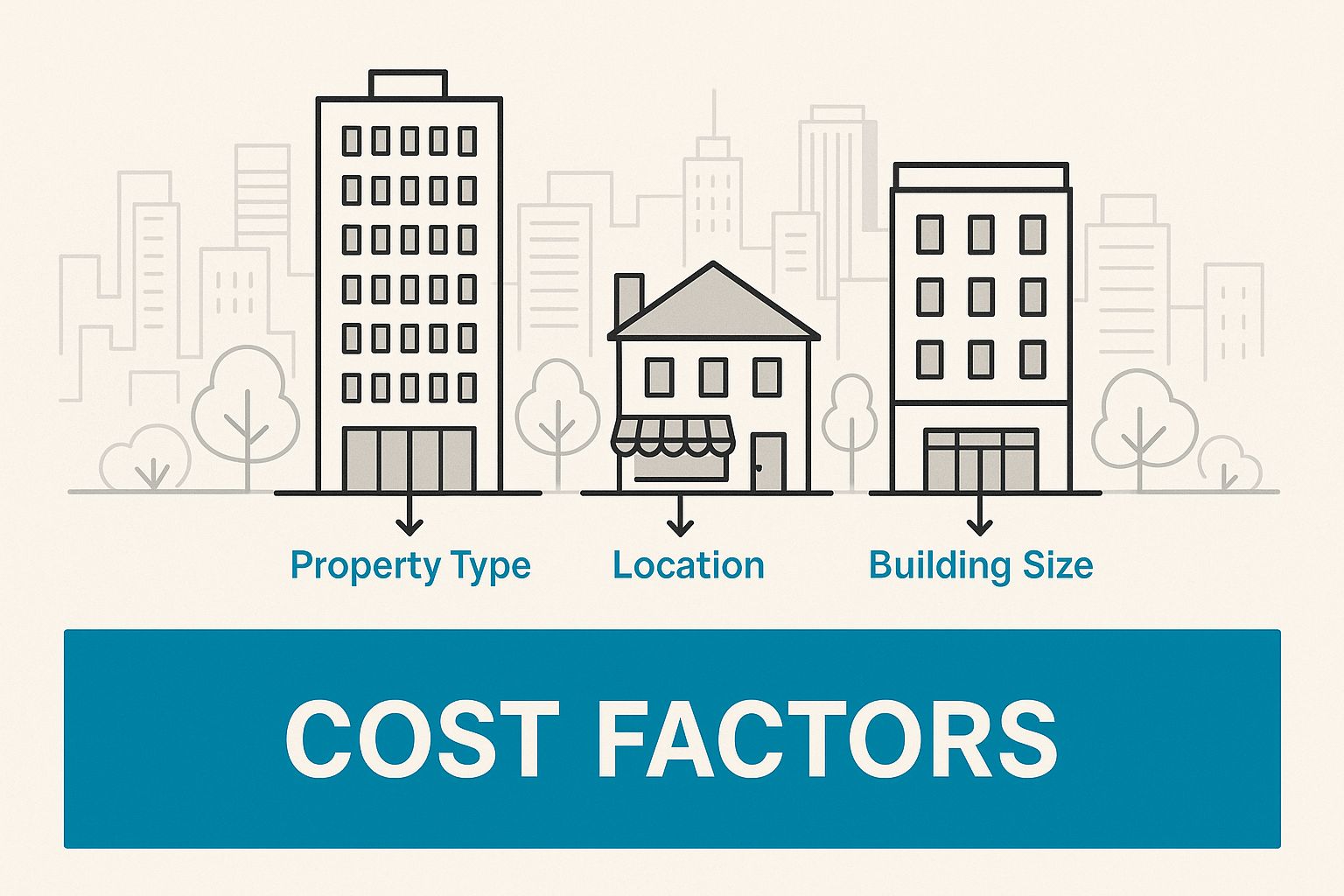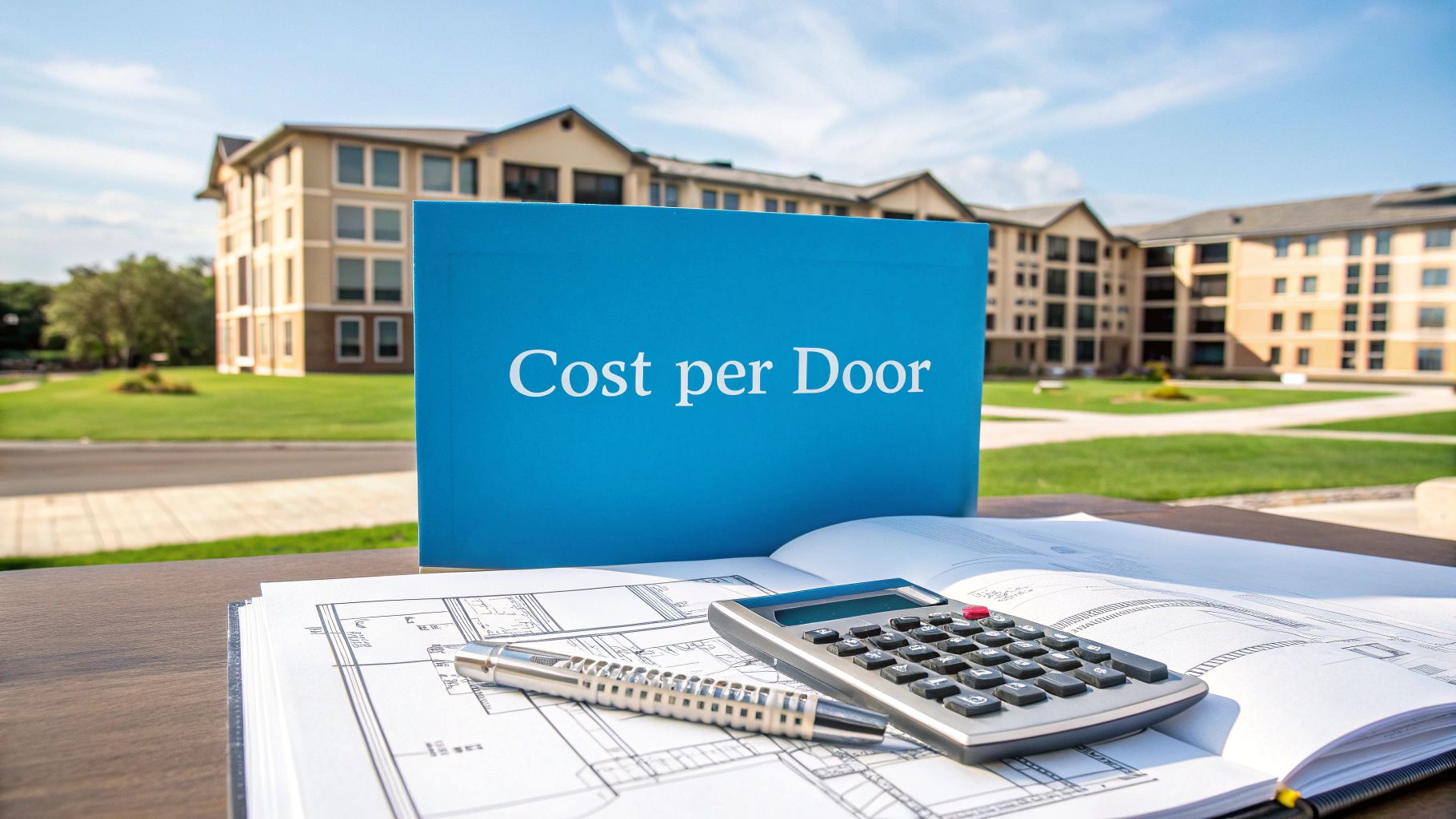When you’re operating a large-scale portfolio, the cost of property management isn't just another line item on a spreadsheet. It’s a strategic investment in the performance of your assets. The real expense goes way beyond a simple monthly fee—it’s a complex mix of direct costs, operational overhead, and the massive opportunity cost of every single day a unit sits empty. For enterprise operators, the focus must shift from minimizing fees to maximizing revenue impact.
The Real Cost of Property Management for Large Portfolios

If you're overseeing anywhere from 1,000 to 10,000+ units, a standard percentage-based fee discussion misses the point entirely. It fails to capture the full financial picture. The conversation needs to shift from, "What's your fee?" to "What is your impact on our Net Operating Income (NOI)?" The sharpest operators don't see property management spend as a cost center; they see it as a key driver of asset performance and portfolio health.
This means getting past basic fee models and focusing on a much more insightful metric: cost per door. This KPI gives you a standardized way to measure operational efficiency that works across different asset types and multi-market portfolios—from scattered single-family rentals to large multifamily buildings without onsite staff. It’s what lets operations directors truly benchmark financial performance, pinpoint inefficiencies, and drive scalable, profitable growth.
Understanding the Core Fee Models
Before we dive deep into a cost-per-door analysis, let's quickly cover the main fee structures. Each one has different implications for your budget, how you incentivize your managers, and your ability to forecast, especially when you're operating at enterprise scale.
- Percentage-Based Fee: The classic model where the manager gets a cut of the monthly rent collected. While it aligns incentives for keeping units filled, it can create unpredictable revenue streams and make budget forecasting a nightmare across a large, diverse portfolio.
- Flat-Fee Model: Simple and clean. You pay a fixed dollar amount for each unit, every month. This makes budget forecasting exceptionally easy, a huge plus for enterprise-level financial planning. The downside? It can disconnect a manager's compensation from critical performance metrics like speed-to-lease.
- Hybrid Model: Gaining significant traction among sophisticated operators, this model blends the two. It usually involves a lower base flat fee plus performance bonuses tied to KPIs like occupancy rates, renewal rates, or, most importantly, reducing Days on Market (DOM). It strikes a powerful balance between predictable costs and motivating results.
The ultimate goal for an enterprise portfolio is to craft a management agreement that actively boosts revenue. This means focusing on outcomes—slashing vacancy days, maximizing lead-to-tour conversion rates, and increasing tenant retention—not just haggling for the lowest possible management fee.
Thinking about your management spend as an investment is the first, most crucial step. If you're looking to tighten up your financial and operational frameworks, our in-depth guide to improve property management operations is an essential resource. Adopting this mindset is how you build a cost structure that doesn't just control expenses but actively grows the value of your entire portfolio.
Now, let's take a closer look at these fee models with a quick comparison.
At-a-Glance Fee Models for Large Portfolios
For operations managers, choosing the right fee structure is critical for aligning costs with performance goals. This table breaks down the most common models to help you see which one fits your portfolio best.
Ultimately, the best model depends entirely on your operational priorities—whether that's cost predictability, performance incentives, or a strategic blend of both. In the sections ahead, we’ll break down how to calculate the true ROI of these options.
Breaking Down Property Management Fee Structures
So, what does property management actually cost at scale? It’s not just one number. The real cost is buried in the fee structure, and for operators managing thousands of units across multiple markets, picking the right one is a make-or-break decision for profitability. Each model creates different incentives and operational headaches.
The demand for professional property management is booming, with the market expected to hit around USD 27.8 billion by 2025. That growth means getting the fee agreement right is more critical than ever. You can dig into the specifics of this global trend in this comprehensive market report.
Let's unpack the most common fee models from an enterprise perspective.
The Percentage-of-Rent Model
This is the old-school classic. Your management company takes a cut of the monthly rent collected, usually somewhere between 4% and 10%. The beauty of this model is that your incentives are seemingly aligned. When your properties are full and rent is high, everyone wins.
But here’s the catch for a large portfolio, say 2,500 units spread across different markets. This model can make your budget feel like a roller coaster. A manager might be incentivized to chase top-dollar rents and focus leasing efforts on your A-class assets while neglecting the B-class properties that require more work. This creates forecasting nightmares and can lead to uneven performance across your portfolio.
The infographic below shows the main factors that sway these costs, especially with a mix of property types.

As you can see, the property type, its location, and the specific services required all get thrown into the mix to determine your final management cost.
The Flat-Fee Model
On the flip side, you have the flat-fee model. This approach is all about predictability, a massive plus for enterprise-level financial planning. You pay a set price per unit every month—for example, $100 per door. It makes your accounting clean and simple, letting you map out your management spend with total clarity.
Key Insight for Enterprise Scale: For a 2,500-unit operation, a flat fee of $100 per door means a predictable monthly management cost of $250,000. That kind of certainty is invaluable when you're projecting NOI and building financial models for growth and investor reporting.
The potential downside? It can create a disconnect from performance. If a manager gets paid the same whether a unit is full or empty, the urgency to fill vacancies and shrink the Days on Market (DOM) can diminish. Without performance-based incentives, this model may not drive the aggressive revenue growth that large portfolios require.
Hybrid and À La Carte Models
To get the best of both worlds, savvy operators with complex portfolios are increasingly turning to hybrid and à la carte models. These flexible structures let you tailor the agreement to your exact operational goals.
- Hybrid Model: This is a mix-and-match approach. Think of it as a lower flat fee combined with performance bonuses. For instance, a manager gets $75 per door plus a bonus for keeping portfolio-wide occupancy above 97% or achieving a sub-15-day average DOM. This gives you predictable base costs while still lighting a fire under your manager to hit key metrics.
- À La Carte Model: This is perfect for operators with strong in-house teams. It lets you cherry-pick only the services you need. If your centralized team crushes marketing and accounting, you can just outsource leasing operations and maintenance coordination. This stops you from paying for redundant services and helps you optimize your cost per door.
For any large-scale operation, there’s no single "best" fee structure. The smartest management agreements are hammered out in negotiations. They must reflect the unique mix of your portfolio and what your business is ultimately trying to achieve, whether that’s locking down costs, maximizing revenue, or a strategic blend of both.
Uncovering the Hidden Costs in Management Contracts

When you’re looking at a management contract, that headline management fee is just the tip of the iceberg. The real cost is often buried in the fine print, where a slew of ancillary fees can quietly erode your portfolio's Net Operating Income (NOI).
These charges might seem minor individually, but when you multiply them across thousands of units, they create serious budget volatility. For large-scale operators, having a transparent, all-in cost model isn't just nice—it's the foundation of predictable profits and scalable operations. You have to look past the base percentage and scrutinize every potential add-on before you sign.
The Most Common Ancillary Charges
When vetting a potential management partner, don't just stop at their main fee. You need to dissect their entire fee schedule for these common—and often costly—extra charges. A seemingly small $50 or $100 fee becomes a massive unplanned expense when it happens hundreds of times across a 2,000-unit portfolio.
Here’s a checklist of the fees that demand scrutiny:
- Tenant Placement or Leasing Fee: Typically equal to 50-100% of one month's rent. This covers marketing a vacant unit and securing a new tenant. For a large portfolio, this is a constant, rolling expense that dramatically impacts your cost per door and must be factored into your vacancy cost analysis.
- Lease Renewal Fee: Some managers charge a flat fee, often $200-$400, to process a renewal for a tenant who is staying. While it's meant to incentivize retention, it can become a significant cost center in a large, stable portfolio.
- Maintenance Coordination Markup: This is one of the sneakiest and most impactful hidden costs. Managers often add a surcharge, typically 10% to 20%, on top of vendor invoices for arranging repairs. Across thousands of maintenance calls a year, this markup can balloon into a major expense line.
- Eviction Service Fee: If you have to evict a tenant, your manager will charge a separate fee for handling the legal paperwork, court appearances, and logistics. These can run from a few hundred to over a thousand dollars per eviction, not including actual court costs.
Negotiating for Predictability and Scale
The key for large portfolios isn't just to spot these fees, but to negotiate them from a position of strength. Your scale is your biggest bargaining chip. A management company is often willing to consolidate, cap, or waive certain fees to win the business your large portfolio represents.
Key Insight for Enterprise Scale: The goal isn't always to eliminate every fee. It's about creating a predictable and transparent cost structure. An all-inclusive fee or clear caps on ancillary charges is often far more valuable for financial planning and NOI forecasting than a slightly lower base rate with dozens of unpredictable add-ons.
For any property management business focused on reining in expenses, mastering effective budgeting strategies is crucial. It helps you build financial models that truly account for all your costs, both direct and hidden.
Try bringing these negotiation strategies to the table:
- Push for an All-Inclusive Fee: Propose a single, slightly higher rate—either a flat fee per door or a percentage—that bundles in most routine extras like lease renewals and maintenance coordination. This delivers maximum budget predictability.
- Negotiate Fee Caps: If an all-in model isn't feasible, work to set annual caps on specific fee types. For instance, you could cap the total maintenance markup at a fixed dollar amount for the entire portfolio for the year.
- Demand Volume Discounts on Leasing: Make the case that the efficiency gained from leasing hundreds of your units each year should translate into a lower per-unit placement fee.
By tackling these hidden costs proactively, you turn your management agreement from a potential financial minefield into a strategic tool that safeguards your profits and supports growth at scale.
Calculating the ROI of Your Management Spend
It’s easy to fall into the trap of viewing property management spend as just another line item on the budget—a cost to be minimized at all turns. For large-scale operators, this is a massive strategic mistake.
Your management spend isn't an expense; it's a direct investment in the performance of your assets. The right question isn’t, "How much does it cost?" but rather, "What's the return I'm getting on this investment?" It's time to shift the conversation from pure cost-cutting to tangible value creation.
This means you need a framework that ties your management fees directly to the KPIs that actually drive your business: reducing Days on Market (DOM), improving lead-to-tour conversion, and optimizing maintenance spend. Anything less is just guesswork.
A Practical ROI Framework for Large Portfolios
To really understand the value your management partner brings to the table, you need a simple but powerful way to measure it. We're not talking about complex financial modeling—just a straightforward formula to bring clarity to their performance.
The Enterprise ROI Formula:
ROI = (Revenue Gained + Costs Avoided) / Total Management Cost
Let’s break that down for an enterprise context:
- Revenue Gained: This is almost entirely about reducing vacancy loss. Every single day you shave off your average DOM across the portfolio is real money—captured rent that would have otherwise vanished. Speed-to-lease is the primary driver here.
- Costs Avoided: This bucket includes all the money you didn't have to spend. Think of the savings from better tenant retention (fewer turnover and marketing costs), lower eviction rates, and optimized maintenance that prevents catastrophic failures.
- Total Management Cost: This is the all-in number. It includes the base management fee plus all ancillary charges.
Using this formula completely changes the dynamic. It forces a performance-based discussion, proving that a slightly higher, all-inclusive management fee that slashes vacancy can deliver a much greater ROI than a cheap, underperforming alternative.
Mini-Case Study: A 2,000-Unit Portfolio in Action
Let’s see how this works in the real world. Imagine an operations director for a 2,000-unit portfolio. Their average rent is $1,800/month (or $60/day).
Their current property manager is... adequate. Vacancy is a constant headache, with an average DOM of 30 days. The total annual management cost, fees and all, comes to $1,920,000.
Now, they switch to a tech-forward management partner who costs more upfront—$2,160,000 annually—but who is obsessed with speed-to-lease. This new partner leverages showing automation to offer same-day tours, successfully cutting the average DOM from 30 days down to just 20.
Let's calculate the Revenue Gained from that 10-day DOM reduction:
- Daily Rent Per Unit: $60
- Days Saved Per Vacancy: 10 days
- Revenue Gained Per Unit Turnover: $60 x 10 = $600
Assuming a standard annual turnover rate of 30% for their 2,000-unit portfolio (that’s 600 units turning over each year):
- Total Annual Revenue Gained: 600 units x $600 = $360,000
While the new manager costs an extra $240,000 per year ($2,160,000 - $1,920,000), their performance generated an additional $360,000 in pure revenue. That’s a net gain of $120,000 straight to the bottom line, completely justifying the higher fee and proving a clear, positive ROI. The conversation is no longer about cost; it's about strategic performance and revenue impact.
There are a lot of ways to get this kind of return, and you can dive into several proven methods in our guide covering 8 ways to boost your portfolio's ROI.
The financial impact of vacancy is often underestimated, especially at scale. The table below puts the cost of a single vacant day into sharp perspective for a large portfolio.
Vacancy Cost Impact Analysis Per 1000 Units
As you can see, even a one-day reduction in vacancy across a 1,000-unit portfolio can unlock $60,000 in revenue. This highlights just how critical speed-to-lease is for financial health and why top-tier management is a revenue driver, not a cost center.
How PropTech Drives Down Your Cost Per Door
For large-scale property managers, technology is the single biggest lever you can pull to gain operational efficiency and shrink your effective cost per door. Your management fee is a fixed expense, but the right PropTech stack is an investment that delivers compounding returns by automating processes, reducing labor costs, and slashing vacancy. This isn't just about convenience; it's a fundamental shift in operational strategy.
A modern tech stack attacks the biggest drains on your NOI. It automates high-volume, low-value tasks, provides critical data for smarter decision-making, and ultimately makes your entire operation leaner and more scalable. The goal is tangible results: lower leasing overhead, reduced marketing spend due to faster lease-up, and tighter control over maintenance expenses.
Automate the Leasing Funnel to Cut Labor and Vacancy
The traditional leasing process is a huge operational bottleneck. Coordinating showings across a distributed portfolio, responding to lead inquiries 24/7, and processing applications manually create immense labor costs that scale directly with your unit count. This is where automation delivers its most immediate and dramatic impact.
Key Insight for Enterprise Scale: The real power of technology is its ability to decouple portfolio growth from headcount growth. Showing automation, for instance, allows a small, centralized leasing team to manage showings for thousands of scattered-site units—an operational impossibility with manual methods.
Showing automation platforms are a prime example. By automating lead response, tour scheduling, and prospect follow-up, these systems directly impact your bottom line:
- Slash Days on Market (DOM): The ability to offer an immediate tour—self-guided or agent-led—to a hot lead is the key to winning the lease. This speed dramatically reduces the time a unit sits vacant, directly increasing revenue.
- Lower Leasing Headcount: Automating the logistical nightmare of scheduling frees up your leasing agents to focus on high-value activities like closing qualified applicants, not playing phone tag. This allows you to manage more doors with a much leaner team, fundamentally improving your cost per door.
Centralize Data to Boost Conversion Rates
Beyond automation, a connected PropTech stack provides unprecedented visibility into your leasing pipeline. Integrated CRMs and property management systems transform a messy swamp of data into clear, actionable intelligence.
For enterprise operators, this is a game-changer. You're no longer guessing. You can see exactly where leads are dropping off, which marketing channels are delivering the highest quality prospects, and how quickly your team is converting interest into signed leases. This data-first approach is crucial for optimizing your lead-to-tour conversion rates and maximizing the ROI of every marketing dollar.
Control Maintenance Spend with Smart Systems
Maintenance is another area ripe for a tech-driven overhaul. Automated maintenance systems can transform repair management from a reactive, expensive scramble into a proactive, data-driven process.
These platforms streamline everything from work order creation and vendor dispatch to invoicing. For a large portfolio, that adds up to serious savings through:
- Bulk Purchasing Power: Centralized systems give you the data to negotiate better rates with vendors based on the total volume of work across your entire portfolio.
- Preventative Maintenance: By tracking asset history, you can schedule intelligent preventative work that avoids costly, catastrophic emergency repairs.
- Tighter Budget Control: Real-time visibility into maintenance spending stops budget overruns before they happen and highlights opportunities for cost optimization.
Investment in property management technology is exploding for a reason. The global market for this software is projected to hit nearly USD 28 billion in 2025 and is on track to double to roughly USD 54 billion by 2032. This growth signals a clear trend: technology is no longer an optional add-on. It's the core engine for profitability and scale in modern property management.
Answering Your Top Questions on Management Costs
When you're managing a large portfolio, the conversation around costs gets serious, fast. It’s not just about a simple percentage; it’s about operational efficiency, strategic partnerships, and how technology can completely change the math.
Let’s tackle the big questions that come up when you're operating at scale.
What's a Realistic Management Fee for a 1,000+ Unit Portfolio?
First things first: forget the standard 8-10% you see in consumer-grade agreements. For portfolios north of 1,000 units, that model is out the window. Your scale is your biggest bargaining chip, and the fee structures look entirely different.
Instead of a flat percentage, you're much more likely to see one of these models:
- Tiered Percentages: This is a common way to reward scale. A contract might be structured as 5% for the first 500 units, 4% for the next 500, and 3.5% on everything after that. The more you grow, the lower your effective rate per door.
- Flat-Fee-Per-Door: For large operators who crave predictability, this is often the go-to. You agree on a fixed dollar amount per unit each month, typically somewhere between $50 and $125. The exact number depends heavily on the property type, market, and scope of services.
- Cost-Plus Model: This is a more transparent, partnership-style approach. The fee is based on the management company's actual operational costs plus a pre-negotiated profit margin. It requires trust and diligent oversight, but it ensures you know exactly what you're paying for.
For a 1,000+ unit portfolio, a fair and negotiable rate usually lands between 3% and 6% of gross rent, or an equivalent flat fee. The final number really comes down to the scope of work and your market.
How Can I Get a Better Deal on My Management Fees?
Your size is your leverage. A large portfolio isn't just another client to a property manager; it's a source of stable, predictable revenue. They want your business, and that gives you negotiating power.
Walk into that negotiation armed with data. Show them your portfolio's performance metrics, its geographic density (a huge plus for them, as it lowers their own travel and labor costs), average rent rolls, and low delinquency rates.
Then, put these strategies into play:
- Go for a Longer Contract: A three- or five-year agreement gives a management company security. In return for that stability, you should absolutely be asking for a lower fee.
- Unbundle the Services: Do you have a killer in-house marketing or accounting team? If so, negotiate to pull those services out of the management agreement. This à la carte approach ensures you only pay for what you actually need, directly trimming your cost of property management.
- Create Some Healthy Competition: Always—and I mean always—get bids from multiple qualified management companies. You don't have to reveal specific numbers, but letting a firm know you have other competitive offers lights a fire under them to bring their best price to the table.
Is a Percentage or Flat-Fee Model Better for a Large Portfolio?
This is the classic "it depends" question, but the choice you make says a lot about your strategic priorities. There's no single right answer, just the one that’s right for your portfolio.
A flat-fee model is all about predictability. When you're forecasting expenses across thousands of doors, having a fixed management cost is a massive advantage for budgeting and financial modeling. It keeps your cost per door consistent and makes the accounting straightforward. No surprises.
On the flip side, a percentage-based fee aligns your manager's goals directly with yours. Their income rises and falls with your rental income, which gives them a powerful reason to push for higher rents and keep vacancy at rock bottom. It's a great way to incentivize top-line revenue growth.
Many of the most sophisticated operators I see are now using a hybrid approach to get the best of both worlds. This might look like a lower base flat fee per door, plus performance bonuses tied to specific KPIs. For instance, a manager could earn a bonus for keeping the portfolio's Days on Market (DOM) under a set number or maintaining an occupancy rate above 97%. This gives you budget stability while still motivating your manager to crush the metrics that matter most to your bottom line.
At Showdigs, we believe technology is the ultimate tool for lowering your true cost of property management. By automating the entire leasing journey from first inquiry to signed lease, we help large-scale operators slash Days on Market, reduce payroll costs, and boost lead-to-tour conversion rates. Our platform was built from the ground up for remote operations and enterprise scale, delivering a measurable ROI that turns your leasing operations from a cost center into a powerful revenue driver.







